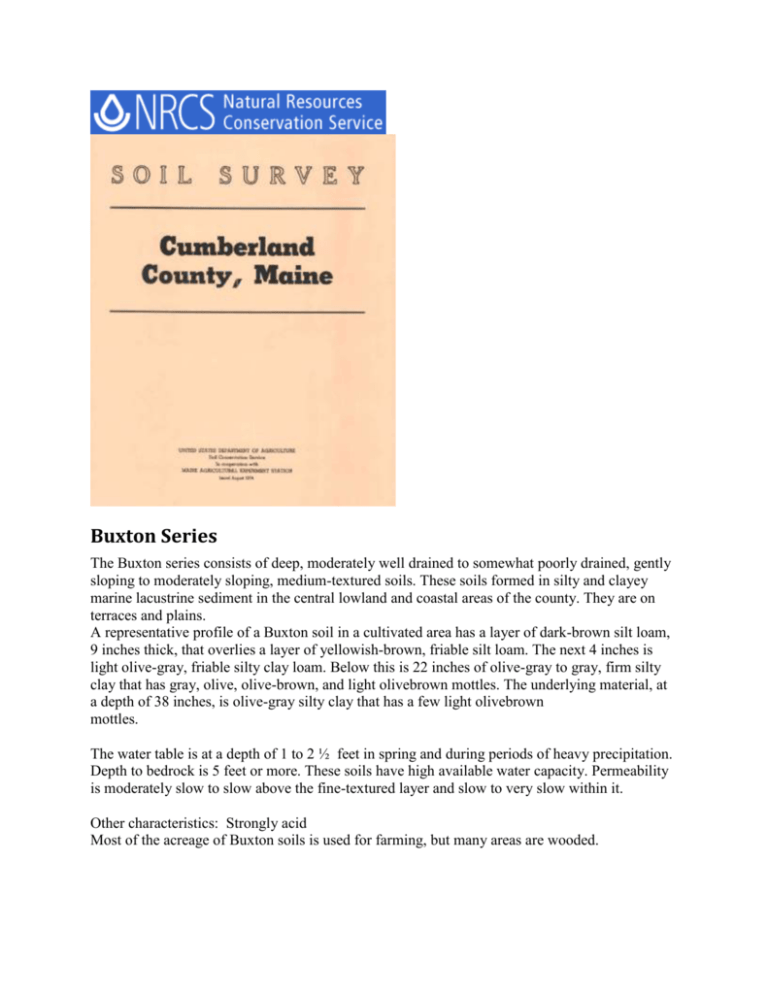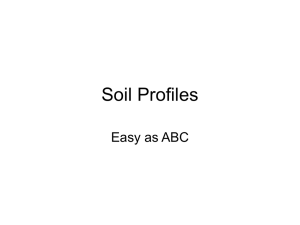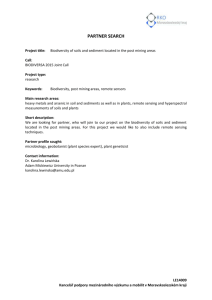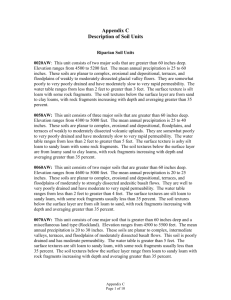Soil Series Descriptions
advertisement

Buxton Series The Buxton series consists of deep, moderately well drained to somewhat poorly drained, gently sloping to moderately sloping, medium-textured soils. These soils formed in silty and clayey marine lacustrine sediment in the central lowland and coastal areas of the county. They are on terraces and plains. A representative profile of a Buxton soil in a cultivated area has a layer of dark-brown silt loam, 9 inches thick, that overlies a layer of yellowish-brown, friable silt loam. The next 4 inches is light olive-gray, friable silty clay loam. Below this is 22 inches of olive-gray to gray, firm silty clay that has gray, olive, olive-brown, and light olivebrown mottles. The underlying material, at a depth of 38 inches, is olive-gray silty clay that has a few light olivebrown mottles. The water table is at a depth of 1 to 2 ½ feet in spring and during periods of heavy precipitation. Depth to bedrock is 5 feet or more. These soils have high available water capacity. Permeability is moderately slow to slow above the fine-textured layer and slow to very slow within it. Other characteristics: Strongly acid Most of the acreage of Buxton soils is used for farming, but many areas are wooded. Hermon Series The Hermon series consists of deep, well-drained to somewhat excessively drained, gently sloping to very steep soils that are moderately coarse textured to coarse textured. These soils formed III granitic glacial till and .contain many small and large stone fragments. They are on uplands in the northwestern part of the county. A representative profile in a wooded area has a layer of forest litter, 1 inch thick, that overlies a surface layer of grayish-brown sandy loam 3 inches thick. The upper 2 inches of the subsoil is dark reddish-brown, friable sandy loam, and the next 10 inches is strong-brown, friable gravelly sandy loam. The lower 6 inches of the subsoil is yellowish-brown, friable gravelly coarse sand. The substratum, at a depth of 21 inches, is very pale brown, loose gravelly loamy sand. A water table generally is at a depth of 3 to 5 feet. Depth to bedrock is 5 feet or more. Permeability is rapid in these soils, and available water capacity is low. A few areas of Hermon soils were formerly used for farming, but most areas are now wooded. Strongly acid. Paxton Series The Paxton series consists of deep, well-drained, gently sloping to strongly sloping, moderately coarse textured soils. These soils formed in very firm stony glacial till and are on uplands in the eastern and central parts of the county. A representative profile of a Paxton soil in a cultivated area has a surface layer of dark-brown fine sandy loam 8 inches thick. The upper 7 inches of the subsoil is yellowish- brown, friable fine sandy loam. The lower 5 inches of the subsoil is olive-gray, friable fine sandy loam. The substratum, at a depth of 20 inches, is a light olive-gray to olive-gray, firm to very firm, fine sandy loam fragipan. Depth to bedrock is 5 feet or more. Permeability is moderate above the fragipan and moderately slow within it. The available water capacity is high. Many areas of Paxton soils were formerly used for farming, but many of these areas are now wooded. Slightly acid Adams Series The very deep, uniformly sandy soils of the Adams series have formed primarily from granitic materials. They are somewhat· excessively drained. The fine and medium sands that make up these soils are at least 4 or 5 feet deep, and in places are many feet deep. The sands were mainly water deposited, but in a few areas they show the influence of wind action as well. The surface soil is dark-brown to strong-brown loamy sand, loose to very friable, and very strongly acid. The subsoil is yellow to light olive-brown fine sand to medium sand, very friable to loose, and very strongly acid to medium acid. The Adams soils occur on dune like areas that have gently rolling or rolling relief and on winderoded sandy knolls. They are most extensive in the central part of Penobscot Valley, around Greenbush, Passadumkeag, Enfield, and Howland. Long, narrow strips are on terraces and small benches. These terraces and benches are along valleys tributary to the valley of the Penobscot River as well as elsewhere in the southern part of the county. Bangor Series The soils of the Bangor series are deep to very deep and well drained. They have formed in firm to very firm glacial till that contains a high percentage of silt and clay. In addition to limeseamed slate, the till includes shale, phyllite, calcareous quartzite, and some sandstone and granite. The surface soil is yellowish-brown silt loam. It is very friable or friable and strongly to medium acid. The subsoil is pale-olive, gritty, heavy silt loam. It is firm or very firm and medium acid to neutral. These are among the leading agricultural soils in the State. They are most extensive in the southwestern wing of the county around Dexter, Exeter, Corinna, and Corinth, where they occupy wide, broad-topped ridges of glacial till. They are less extensive in the towns of Patten, Carroll, Prentiss, and Drew. In these areas they are frequently adjacent to the even more silty Perham and Daigle soils. The Bangor soils are productive but require most of the fertilizer nutrients, particularly nitrogen, for good yields. Lime is also required for most crops because nearly all Bangor soils are strongly acid in their surface layers. Thorndike Series The soils of the Thorndike series are very shallow to moderately deep and well drained. They have formed from thin, slaty glacial till and in residuum from underlying lime-seamed bedrocks. The bedrock is mostly slate, shale, phyllite and, in the northern part of the county, some calcareous quartzite. The upper layers in tilled areas are grayish brown, very friable or friable, and very strongly to strongly acid. The subsoil is pale brown or dark brown, friable, and strongly acid to medium acid. Depth to bedrock usually 2 feet. In wooded areas the upper layers include a mat of forest litter and a light-colored leached laver. The Thorndike soils are common in the southwestern corner, the central-eastern wing, and the extreme northern part of the county. They are scattered throughout other areas. Rock outcrop, which includes Thorndike soil materials, is common in all of the high and mountainous areas of the central and southwestern parts of the county.



